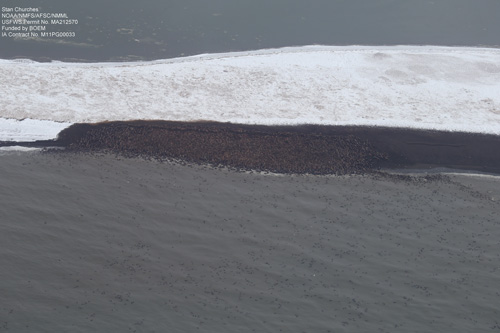
Aerial surveys of arctic marine mammals photograph walrus haulout site; Scientists call behavior a new phenomenon
October 01, 2013
Thousands of Pacific walruses haul out of the ocean on a remote barrier island in the Chukchi Sea, near Pt. Lay
In 2011, scientists estimated that 30,000 walruses were hauled out along one kilometer of beach near Pt. Lay. “Large walrus haulouts along the Alaskan coasts in the northeastern Chukchi Sea are a relatively new phenomenon,” said Megan Ferguson, marine mammal scientist with NOAA Fisheries. “NOAA’s research doesn’t typically extend to studying walruses, since this is a species managed by the U.S. Fish and Wildlife Service (USFWS), so you can imagine how exciting it was for us to be able to collect such valuable data for our partner agencies.” Conserving and restoring protected species such as whales is one of NOAA Fisheries’ core missions. The goal of the surveys is to document the distribution and relative abundance of bowhead, gray, minke, fin whales, beluga whales and other marine mammals in areas of potential oil and natural gas exploration, development and production activities in the Alaskan Arctic. “In addition to photographing the walrus haulout area, NOAA scientists documented more bowhead whales, including calves and feeding adults in the Beaufort Sea this summer compared to 2012,” said Ferguson. “We are also seeing more gray whale calves in the Chukchi Sea than we have in recent years.” Documenting the walrus haulout near Pt. Lay was a bonus for the scientists, since this information provides useful data for partners studying walruses in the Arctic. One of the reasons photograph documentation of the walrus haulout areas is so important is because seeing so many along the beaches is a relatively new phenomenon. In the past, walruses used sea ice habitat offshore in the northern Chukchi Sea as resting platforms in between dives to the bottom of the shallow Chukchi Sea where they feed on their preferred prey, including clams, snails and worms, during the summer and autumn. Due to loss of ice in offshore areas, walruses are foraging in more coastal areas and using beaches for resting (hauling out). The first large beach haulout in this region formed in 2007 near Pt. Lay, coinciding with an unprecedented loss of sea ice across the Chukchi Sea. Subsequent haulouts formed in northwestern Alaska near Icy Cape and Cape Lisburne in 2009, and near Pt. Lay in 2010, 2011 and 2013. During 2008 and 2012, remnants of sea ice offshore in the Chukchi Sea were sufficient for walruses to rest on between foraging bouts. NOAA Scientists involved in the aerial survey project collaborate with several other federal, state and local agencies and universities by sharing field resources, data or information. In addition to BOEM, agencies and organizations include the U.S. Fish and Wildlife Service, Alaska Department of Fish and Game, U.S. Coast Guard, North Slope Borough, Duke University, University of Alaska Fairbanks, and other entities conducting research in the Arctic. "The coastal aerial surveys carried out by the NOAA team provide valuable information about the timing and location of coastal haulout formation on the Chukchi Sea coast,” said Joel Garlich-Miller, Wildlife Biologist with the USFWS. “Scientists and coastal communities use walrus haulout information to establish and adapt protection measures to minimize disturbances from aircraft overflights and ship traffic. The coastal surveys also provide valuable baseline information about important coastal habitats for walruses, which can be used to evaluate and mitigate potential impacts of proposed projects in the Chukchi Sea region." “Aerial photographs taken by the NOAA team provide a context for the USGS walrus tracking studies and allow USGS to make mission critical logistics decisions on when to deploy our teams and when to conduct our work with walruses on shore,” said Tony Fischbach, Wildlife Biologist with the US Geological Survey. “The NOAA team efforts are invaluable, as we all seek to understand how walruses are adjusting their behavior and movements in response to the loss of summer sea ice.” NOAA scientists from the Alaska Fisheries Science Center's National Marine Mammal Laboratory are planning to conduct almost daily flights through October, weather permitting -- and budget permitting depending on the government shutdown which began on October 1st. Plans were for the public to be able to find near real-time updates on the surveys via daily reports posted to the website: http://www.afsc.noaa.gov/nmml/cetacean/bwasp/index.php This study is being funded and co-managed by the Bureau of Ocean Energy Management (BOEM)’s environmental studies program.
Edited by Mary Kauffman, SitNews
Source of News:
E-mail your news &
photos to editor@sitnews.us
|
||
